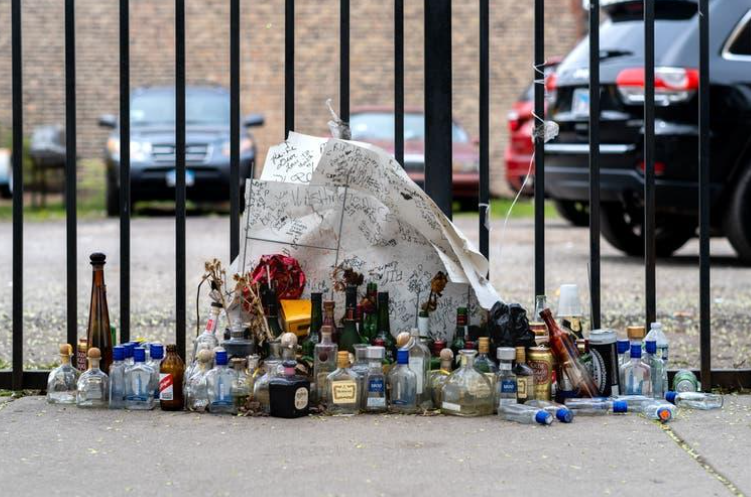“Some people hardly know there are other jobs besides dealer and cop.” On the road in Chicago’s most notorious gang neighborhood
Chicago is considered the gang capital of the world. In the South Austin neighborhood, where drugs and guns are more readily available than healthy food, ex-gang members try to keep young people from taking the fatal path into gang crime. To be sure, the days of large, organized gangs are over. But that doesn’t make the situation any less dangerous.
David Signer (text), Katja Müller (pictures), Chicago
NZZ – 08.07.2023
During the day, there are hardly any people on the road here. A few young men stand at the intersections. Now and then a car stops. A woman in a minijupe staggers across the street. From a distance, she looks about twenty. As she approaches, the yellowish, haggard face that could belong to a sixty-year-old becomes visible. She waves and slurs at drivers to stop, and is almost run over.
Many apartment buildings and stores along Cicero Avenue are rundown and abandoned, their entrances and windows boarded up, smeared with graffiti. Liquor stores and churches are mostly still open, all with massive barred windows. Trash covers the sidewalks and lawns.
A group of young people in red hoodies are standing around. One sweatshirt says “Never broke again” – “Never broke again”.They have placed office chairs at the edge of the sidewalk; it looks like a workplace, and that’s what it is: they sell weed.

In South Austin, there are countless liquor stores, but hardly any supermarkets with fresh goods.
One street over, a sign indicates that no “loiterers” are welcome here.A mother says that when she leaves the house, she gets right into the car and drives off. She doesn’t spend a moment longer on the road than absolutely necessary because, “Bullets have no eyes.”
This is South Austin on the Westside, one of Chicago’s most dangerous neighborhoods. It’s part of the Austin neighborhood: 100,000 residents, 76 percent African American, 17 percent Latino. Nearly a quarter are officially unemployed. The median income is $35,000 a year; in the greater Chicago area, it’s more than double that. There are only half as many Internet connections as the city average, but twice as many single-parent families.
In the 1970s, Austin was still an affluent, mixed neighborhood. But with the immigration of African Americans from the southern states, the “white flight” that was widespread in the United States began:
The “flight” of whites who did not want to live in a “black neighborhood.” With each one that left, the exodus was accelerated. A downward spiral began: Businesses closed, jobs disappeared, tax revenues fell, infrastructure and institutions deteriorated, eventually leading to the exodus of the black middle class.
Then came crack cocaine, opioids, prostitution, HIV, the gangs, violence and the mass incarceration of young African Americans, often for petty crimes.
From gang founder and murderer to Samaritan
“Look around,” Booney says. “Just trash. They’re eating garbage at the fast food joint, drinking garbage from the liquor store, buying garbage on the street corner, there’s garbage everywhere. Unsurprisingly, then all that comes out is garbage. A kid who grows up here is going to feel like garbage later on, too.”
Booney, 63, gray dreadlocks, is actually named Clifton McFowler. But everyone here knows him by his nickname.
Booney grew up in Austin. By the time he was thirteen, he was doing all kinds of drugs and robbing the johns who came to the neighborhood. “I never left home without a gun and a bulletproof vest,” he says. Of his parents, he says, “My father was in jail most of the time, and my mother was an alcoholic and schizophrenic.”
In 1972, Booney and friends formed the gang “Cicero Undertaker Vice Lords,” named after a neighborhood funeral home. To get in, you had to break a window at night and look at the bodies.
The institute still exists. Booney stops in front of it for a long time. The business advertises with the slogan: “Promise a lot – deliver even more.” More coffins, more funerals?
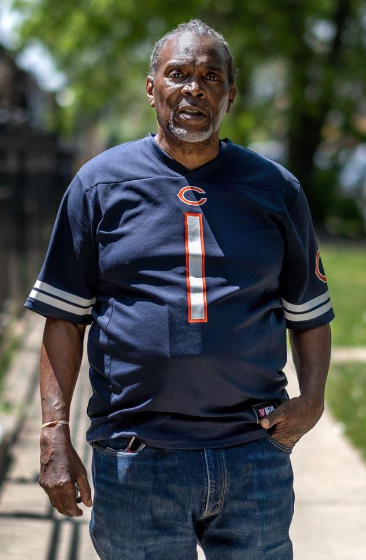
Clifton McFowler, known as Booney, started a gang as a teenager. Today, he uses the Build organization to try to keep youths from joining gangs.
Even as a teenager, it was Booney who provided financially for the family and watched over his younger brother to make sure he went to school regularly and didn’t go astray. “He was mad at me for that,” Booney says. “He said I just didn’t want him to make as much money as I did.” Today, the brother is in real estate and a millionaire.
Booney himself rarely strayed into the classroom; instead, he landed in juvenile detention time and again. Then, in 1982, came the minute that changed his life: He committed a double murder. “I didn’t even know the men,” he says. “It was a drug thing.”
He was sentenced to 27 years in prison. Five of those he spent in solitary confinement. “It was illegal, but who cared?” Booney still has the image of the cell on his phone: a toilet, a cot, barely any space next to it. “I had nothing to do all day, couldn’t talk to anyone. I passed the time by trying to remember good times in my childhood. Only on Saturday could I get out for fifteen minutes to take a shower.”
In 2009, he walked free with nothing but twenty dollars and a bus ticket in hand, and shortly thereafter became addicted to heroin. After rehab, Booney decided to make amends for what he had done in his former life.
“We thought we were doing something for black people when we robbed white johns. In reality, we were destroying the neighborhood.”
He points to a Family Dollar store that has been looted and demolished. The entrance is barricaded with boards, the place closed. Hardly anyone dares to open a business here anymore. The neighborhood is a “food desert”: “There is only junk here. If you want to buy something healthy, you have to drive half an hour to the next neighborhood,” Booney says. In the few stores still open, vendors sit behind bulletproof glass and pass the goods on a turntable. There’s often a sticker next to the pass-through that reads, “Don’t destroy Black business.”
“Because of all the babies, I do all this shit”.
“I served my sentence, and it was bad,” Booney says. “But the real punishment is that I have to look at what people like me have done to the neighborhood here every day. It’s a good punishment.”
Booney now tries to keep young people from going down the path he himself took at the time with the organization Build. Founded in 1969, Build now has more than a hundred employees. Last year, the organization was in contact with 3,000 Westside residents; 96 percent of those who had already been to prison did not relapse. 74 percent were able to improve their grades in school. 48 gang members were persuaded to leave.
“I was part of the problem, now I want to be part of the solution,” Booney says. “I’m trying to save as many as I can. I don’t want them to be like me forty years from now, seeing the devastating effects of something they did when they were young.”
Walking through the neighborhood, we meet Poncho, who was also in the gang with Booney at the time. They embrace warmly. The two men show each other pictures of their grandchildren on their cell phones, and talk about the gang’s leader at the time. He is still in prison.
Everyone in the neighborhood knows Booney. Every few steps he is stopped, everyone wants something from him. Even that evening, on his way home, his phone rings incessantly. He is exhausted, but responds to every request.
“My place burned down, can you get me some new furniture?” one asks. Sure enough, the next day Booney rides with him to a cluttered house that needs to be cleared, and hauls off some tattered free furniture.
Once again, Booney has set up way too many meetings that day. He wants to please everyone, he wants to pay off a debt, make up for lost time. That’s why he can never say no. “I’ve done so much serious shit, I have to make up for it with good,” he says. “I used to be respected here because of my gang. Now I’m respected because I help people.” He wants, he says, to make the “hood” a “neighborhood” again.
Next to his house, he has prepared a garden. Children come here after school to grow vegetables. “There are no guns and no drugs here,” he says. “The dealers respect what I do. It’s a safe haven.”
Later, outside the house, Booney’s granddaughter runs up to him and hugs his legs. “It’s because of her and all the other babies that I do all this shit,” he says, smiling wearily. For him, everyone under 20 is a «baby».
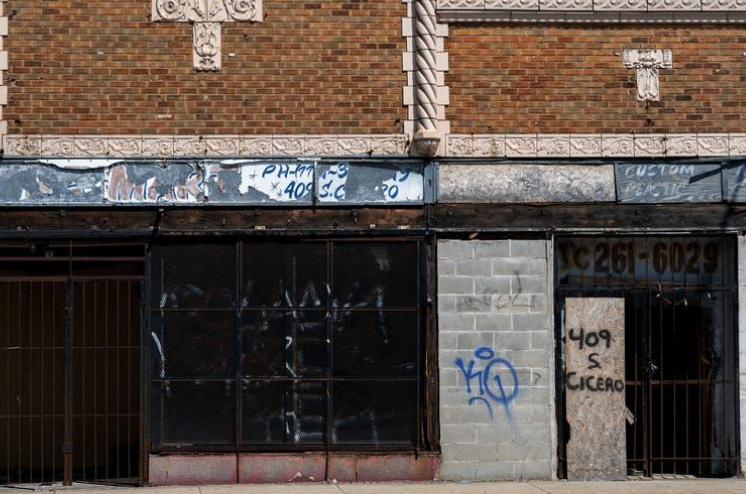
A vacant building in South Austin, Chicago.
Smaller gangs, but with more guns
Today’s gangs are different from those Booney dealt with as a gang member. “The big gangs have all been broken up,” he says. “Today, small groups called cliques dominate. They have no hierarchy or organization, but they have all the more weapons.”
Booney says in his day, gangs fought mostly against each other. It was about territory and skin color. “Kids getting shot in their own neighborhoods like today, that didn’t exist back then.” The police also used to function like a gang, he says. “Sometimes they would catch us and drop us off in a rival gang’s neighborhood. Then we had to fight our way back to our own turf; that fueled the fights instead of calming them down.”
Booney’s tales are consistent with research findings. Keiron McConnell has worked as a police officer in gang units for decades, as well as conducting investigations in several cities, including Chicago. He teaches criminology at Kwantlen University in Surrey, Canada. He says in conversation, because of movies and music, most have an outdated image of gang culture. Many things happen more discreetly and unspectacularly than the movies or video clips suggest: “For example, a large part of the drug trade today takes place over the Internet.”
Also, he said, in many places the time is gone when gang members had a clear territory that they marked with tags and where they recognized each other by their tattoos. “Often gangs today consist of only a handful of people. The composition changes all the time, and sometimes they don’t even all know each other.” Mockingly, he says that members often don’t even call themselves a gang anymore, but an organization – “as if they were on welfare.”
Not rebels, but a reflection of society
Gangs have more to do with ourselves than we give them credit for. They may be considered counterculture, McConnell says, but in reality they are always a reflection of the society at hand. For example, in multicultural and affluent Vancouver, gangs are not ethnically organized but mixed, and members are often multilingual white-collar criminals who operate internationally, he says. Violence is avoided, preferring to operate under the radar; this is in contrast to Chicago, where gang members tend to be poor, uneducated, and violent.
Gangs often function as a caricature of the prevailing culture. This is particularly noticeable in the United States: Gangs are extremely money-focused, McConnell says; they operate a cult of guns and violence; they believe in authority, are family-oriented and conservative, especially when it comes to male-female role models.
Moreover, they are completely caught up in groupthink (“us against them”). McConnell reports of gang members who would spend their entire lives within a six-block radius; their horizons and ideas of norms were correspondingly narrow. Booney, too, still lives in the same neighborhood where he grew up.
In short, the gangs are not rebels; they do not embody an anti-America, but rather an “America on steroids”: they display typical traits of the country in pumped-up form.
Chicago is sometimes called the capital of gangs. It also bears – as in Spike Lee’s film of the same name – the nickname Chi-Raq. The term alludes to the fact that the city has recorded more murders since 2000 than there were American fatalities in the Afghanistan and Iraq wars combined.
In 2020, there were 771 homicides in the city, or 28.6 per 100,000 residents. The U.S. average is 6.5, and the Swiss average is 0.38. In individual Chicago neighborhoods, such as South Austin, where Booney also lives, the rate is even three times higher, according to McConnell. In that small area, he said, shootings occur at least once a day. At least half of those are gang-related.
More and more women join gangs
In such hotspots, up to one-third of youths are in gangs, and the number is rising. McConnell says more and more young women are joining them. There are also all-female gangs, such as the “Bad Barbies.” “This is a downside of feminism,” McConnell says. “Women are no longer content with menial tasks; they want the same roles as men, and that includes killing. Because the justice system tends to view them as victims, they can often expect more lenient sentences than men, which is why they often have to take on or take on risky jobs.”
Kenyeda Allen is 24 years old. At 14, she joined a gang that consisted of both male and female members; at 19, after a prison sentence for drug trafficking, she managed first to get out of the gang and, after rehab, out of drugs; then she caught up on her schooling. Now she is training to be a medical assistant.
For the past year, she has been working for the organization Violence Interrupters, trying to keep young people from joining gangs. “I grew up in different neighborhoods in Chicago,” she says. “It’s dangerous for a male gang member to leave his own gang territory, but for a girl like me, it was okay. We’re perceived as less threatening.”
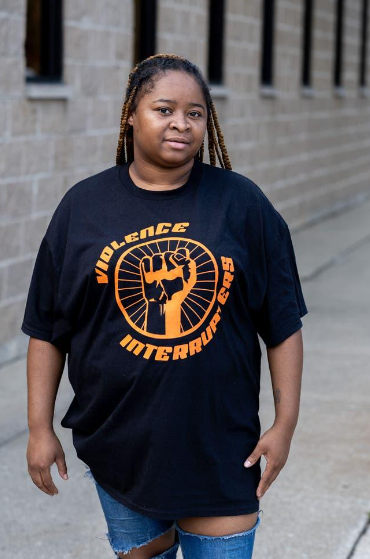
Kenyeda Allen used to be a member of a gang. Today she works for the organization Violence Interrupters and tries to keep young people off the streets.
Kenyeda’s father was in prison for twenty years, and her mother was also in a gang. When Kenyeda broke away from the gang, her parents congratulated her; for her friends, however, she was a traitor. She still wears a tattoo from her gang days: a winged heart with a devil’s tail and horns. Underneath it says “Bitches.” She could have it removed, but she’s not in denial about her past. On the contrary, it enables her to do the work she does today.
In conversations, Kenyeda tries to make young people understand the risk of ending up in prison and what that means. “The cell consists of a bed and a toilet,” she tells them. “You share it with people you may not like. You get terrible food and shower with fifty complete strangers. Is that really what you want for the next ten or twenty years?” Occasionally, she locks a teenager in the bathroom for a few hours, without a cell phone. So he can get a premonition. “Sometimes,” she says, “you have to be a little hardcore with them.”
Not only are there more and more women in gangs, their members are getting younger. “It starts as young as 10 now,” Kenyeda says.
She explains it by saying that some families have known only this world for generations. “Violence is normal for them; they don’t know any other way to deal with conflict.”
Kenyeda says her sister adopted a boy when his father died. “The mother was a drug addict. The boy is sixteen now, has been in the gang for six years, and has been shot 15 times. He’s in too deep, he can’t get out.” Today’s gangs are more brutal than they were in their day, he said. “There are more guns, and the shooting is faster.” Even 12-year-olds specialize in carjacking, armed carjacking, Kenyeda says.
What’s striking about the children and teenagers Kenyeda tells us about: Even at a tender age, they seem hardened like war veterans, but at the same time naive. They have hardly gone to school and are happy when Kenyeda takes them to a restaurant, to the movies or to the city center with its skyscrapers. Their horizons are extremely narrow. “Some hardly know that there are other jobs than gangster and policeman, how to apply for a job or how to fill out a form,” Kenyeda says.
Street credibility” more effective than repression?
The criminologist McConnell has written the book “Stop Gangs Now. The title suggests, in a typically American, shirt-sleeved way, that if only we proceeded decisively enough, we could solve the problem overnight.
Contrary to the martial appeal, McConnell argues for prevention and intervention. He considers the attempt to react to street violence with massive police presence, repression and arrests, i.e., with methods that are referred to in the U.S. as “Tough on Crime” and “War on Drugs,” to have failed.
Repression, he believes, should be limited to the masterminds. “But you don’t just lasso and colt them,” he says. At the same time, he realizes that the “soft” methods take a long time to work. “That’s why no politician advocates them,” the criminologist says “In prevention, you pay the bill now, but somebody else is going to eat.”
McConnell says his fellow American police officers often can’t believe it when he tells them he usually goes on gang patrol unarmed because the risk of getting shot is lower that way. To which it must be added that McConnell looks like a closet and is a martial arts instructor.
McConnell believes that the most effective weapon against gangs is organizations of people who themselves come from the problem neighborhoods, know the conditions and have “street credibility.”
This is in line with Chicago criminologists such as Greg Scott and John Hagedorn, whose research shows that self-help initiatives are much more effective than police interventions. Chicago’s new mayor, Brandon Johnson, is also backing these approaches. In doing so, he is following organizations like Build, with which Booney is involved, or the Violence Interrupters, with which Kenyeda works, and which was founded by Tio Hardiman.
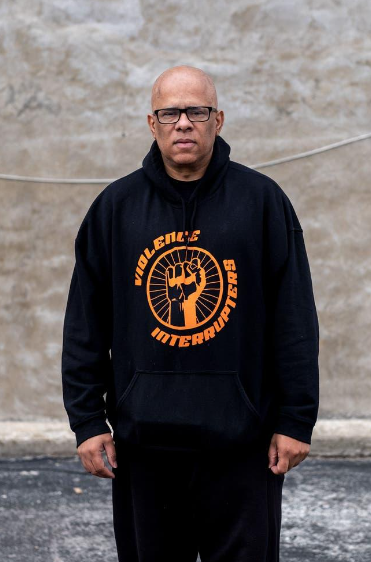
Tio Hardiman, the founder of «Violence Interrupters»
Tio Hardiman grew up on Chicago’s Westside. His task force’s headquarters is in the Westside’s most precarious neighborhood, Austin, which is where Mayor Johnson and Booney live. The most important part of their job is keeping in touch. He knows all the people from the scene personally, and if something happens somewhere, he doesn’t have to get a picture first – like an outside police officer – but usually knows the history of the conflict before he arrives.
“But at best, we can intervene before violence happens,” Hardiman says. He speaks of the cycle of revenge that needs to be broken. “If we hear about a violent altercation, we go there immediately and talk to the victims first and foremost,” he says. “We know that if we don’t, they will be tomorrow’s perpetrators.” The Violence Interrupters’ work isn’t limited to de-escalation, however. They try to keep people out of the gang world by helping them find housing and jobs or organizing recreational activities. “If a youth has been playing basketball with someone else, he might think twice about just knocking him down in a fight,” he says.
Hardiman, unlike Booney, was never in a gang himself, but he knows their world. “My stepfather was a junkie,” he says. “One time we were sitting in the darkened kitchen with some of his buddies. Suddenly there was a fight over a harmless insult, and one shot the other. I was eight, and my father just said, go to your room.”
When Hardiman was 16, he was beaten and robbed by a man from the neighborhood. Hardiman told his stepfather, and he killed the perpetrator.”You can’t imagine how upsetting that was. On the one hand, I was proud of how passionately my father defended me. On the other hand, it was as if I had killed my colleague myself.”
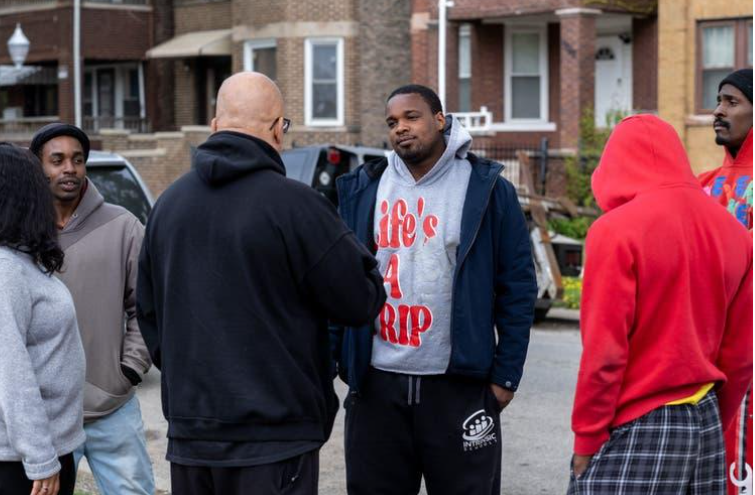
Tio Hardiman and a staff member from Violence Interrupters talk to youth on the street and offer help.
The police doesn’t come
Such erratic behavior remains typical today, he said. “People have zero frustration tolerance. Because of the difficult conditions and also the drugs, they are constantly on the verge of a nervous breakdown,” he says. “Some of them swallow so many pills that afterward they don’t even remember they killed someone.”
“It’s like the whole neighborhood is traumatized,” Hardiman says. “One time, someone almost shot me because I made a wrong turn and blocked traffic. In widespread carjacking, the drivers of the stolen car are often killed, just to cover their tracks.” Twice, Hardiman suffered gunshot wounds during an intervention.
Hardiman is not anti-police. “There’s a lot of misunderstanding there,” he says. “Ninety percent of the people in Austin are happy to have law enforcement. But we’re against their recklessness.” Uniformed officers, he says, forget that they’re supposed to be helping.
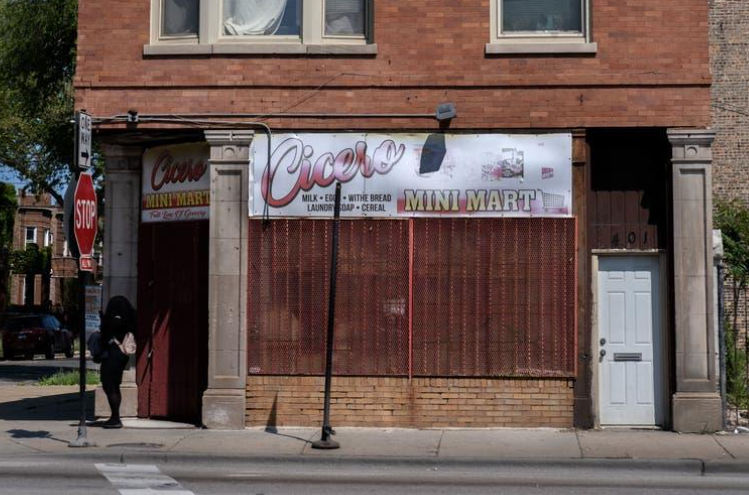
In South Austin, almost all grocery stores have been closed.
As if to prove the point, the manager of a daycare center walks in at that moment and tells Hardiman that the day before, some men had been selling drugs in front of the facility. Despite fear of revenge by the dealers, she called the police. But no one came.
Fragmented and unpredictable
Hardiman also confirms that the large gangs have been replaced by small groups – except in the jail. “There, the old gang order still prevails, with its strict hierarchy and brutal punishments,” he says.
Booney recalls that the jail where he served nearly half his life was controlled by gangs, not the administration. “They even did the operational accounting.” According to experts, the dominance of gangs in prisons is widespread and has to do with the fact that life there is often so dangerous that you don’t survive on your own. You need a strong group under whose protection you can place yourself and which guarantees a certain order.
Today’s fragmentation of gangs outside of prisons is both a police success and makes monitoring, dialogue and prevention more difficult, Hardiman says.
“There are hardly any influential contacts or leaders left who are powerful enough to conduct negotiations and enforce decisions,” he says as he walks past a beautiful park in South Austin. The flowers around the fountain are blooming. But the front gate is locked with a large lock, and the park has been closed because of dealers. “There are some playgrounds in the neighborhood,” Hardiman says. “But the kids don’t use them anymore. Too dangerous.”
A block away, residents have erected a small memorial made of empty liquor bottles for a man who was shot by a gang.
